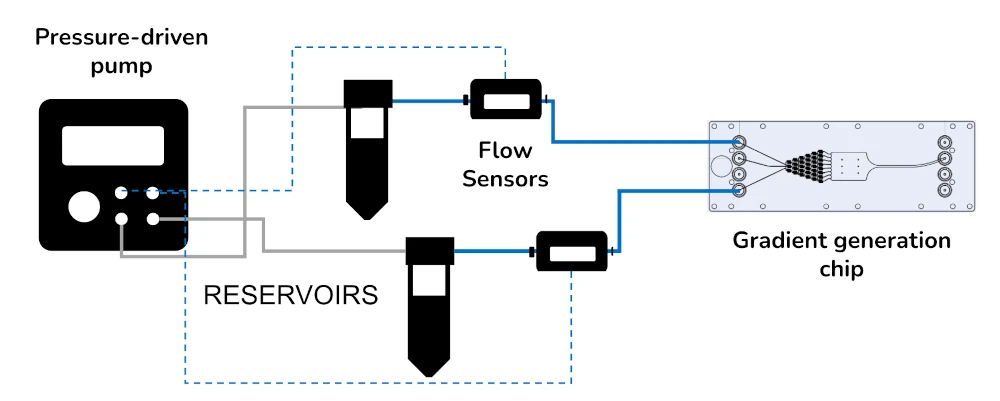Microfluidic Concentration Gradient Pack
Fluid concentration gradient straight out of the box using microfluidics
Easy concentration gradient generation
Set up and start your experiments right away
Easy gradient monitoring
Material transparency and wide gradient area for reaction monitoring
Steadily progressive gradient
Smooth gradient thanks to the 6 stages of serpentine channels

Need a microfluidic SME partner for your Horizon Europe project?
Concentration gradient generation
Using the concentration gradient pack, creating a concentration gradient between two fluids in a microfluidic channel has never been easier. This pack can be used for many possible applications, like long-term cell investigations. It can also be used for applications such as drug development or chemotaxis observation to study biofilm formation.
Based on a flow controller and a gradient generation chip, this highly customizable pack contains all the required parts for researchers to set up their concentration gradient experiment with high gradient stability and control. Microfluidic experts will offer you support during the installation of the microfluidic platform.
A standard steady-state concentration gradient pack contains two pumping channels that push the two fluids to mix through the gradient generator chip, creating a progressively incorporated liquid at the chip’s gradient area. The serpentine-shaped microchannels allow the mixing of the two fluids before they reach the chip’s gradient area.
The efficiency of the concentration gradient generation will be directly linked to the fluid’s properties and the flow rate inside the channels. Flow rates can be measured thanks to a microfluidic flow sensor (eg. Galileo).
Concentration gradient pack setup
An all-in-one pack guarantees good compatibility between the different instruments, allows you to start your experiment right away, is piloted by a single software and can be used for other different microfluidic applications. Therefore, this pack is the simplest way to set up a microfluidic concentration gradient experiment.

Setup
Flow sensor (Galileo, MIC)
Software (Galileo user interface)
Flow controller
Falcon reservoirs
A gradient generation chip from microfluidic ChipShop
All necessary accessories: tubing, connectors, filters, etc…
Microfluidics concentration gradient principle
Regulated concentration gradients of biomolecules control many essential cell functions within the human body [1], such as immune response, wound healing, or embryogenesis [2, 3, 4].
Creating a gradient between a medium and a drug can allow one to precisely measure the drug’s effect on a specific entity depending on its concentration [5].
The composition of solutions can be directly measured at a specific point of the gradient by doing a colorimetric assay. The gradient is dynamic as it is possible to change its shape by changing the flow rates of each fluid inserted in the chip [6].
Creating a gradient is very useful for a lot of applications in chemistry, like the growth of crystals [7] or nucleation [8], and in biology, like growth cone guidance [9] or chemotaxis [10], for example.
References
Alicia G. G. Toh, Z. P. Wang, Chun Yang; Engineering microfluidic concentration gradient generators for biological applications; Microfluid Nanofluid 2013, DOI 10.1007/s10404-013-1236-3
Kothapalli CR, van Veen E, et al. (2011) A high-throughput microfluidic assay to study neurite response to growth factor gradients. Lab Chip 11(3):497–507
Lin F (2009) A microfluidics-based method for analyzing leukocyte migration to chemoattractant gradients. Methods Enzymol 461:333–347
Heo YS, Cabrera LM et al (2010) Dynamic microfunnel culture enhances mouse embryo development and pregnancy rates. Hum Reprod 25(3):613–622
W. Siyan et al. / Journal of Pharmaceutical and Biomedical Analysis 49 (2009) 806–810
N.L. Jeon, S.K.W. Dertinger, D.T. Chiu, I.S. Choi, A.D. Stroock, G.M. Whitesides, Generation of Solution and Surface Gradients Using Microfluidic Systems, Langmuir, 16 (2000) 8311-8316
Aizenberg, J.; Black, A. J.; Whitesides, G. M. Nature 1999, 398, 495-498
Aizenberg, J.; Black, A. J.; Whitesides, G. M. J. Am. Chem. Soc. 1999, 121, 4500-4509
Song, H. J.; Poo, M. M. Curr. Opin. Neurobiol. 1999, 9, 355-363
Wilkinson, P. C. J. Immun. Methods 1998, 216, 139-153
Why use microfluidics for concentration gradient generation?
Microfluidics is an efficient way to decrease the amount of potentially valuable samples needed for an experiment, reducing the costs of experiments.
Decreasing time and length scale is crucial for drug development and chemotaxis studies. Studying one cell or particle at a time in a microfluidic channel with very well-tuned fluid properties is also possible.
Microfluidics make static concentration gradients more stable on long-term scales than gradients in macroscale experiments.
Other microfluidic chips can be easily added before or after the gradient generation chip to create a more integrated platform for complex experiments.

References
1. Cooksey, G.A., Sip, C.G., Folch, A. (2009). A multi-purpose microfluidic perfusion system with combinatorial choice of inputs, mixtures, gradient patterns, and flow rates. Lab on a Chip, 9(3), 417-26
Customize your pack
The gradient chip provided by Microfluidics ChipShop is available in Cyclic Olefin Copolymer (Topas COC) or polystyrene (PS) materials; the material can also be hydrophilized to improve capillarity-induced flow.
Bubbles can be a problem when creating good gradients. A bubble remover can be added to the pack to be placed before the microfluidic chip, which can remove any bubbles that pass through it.
You can contact our experts to answer questions about this concentration gradient pack and how it can match your specifications.
Frequently asked questions
How can we help in your experiment?
This pack is in beta testing phase. So, although the instruments are not fully industrialized, we can provide extensive support as part of our beta testing program. Get in touch to see if you are eligible.
Can the pack be customized based on my specific application?
Yes! Our experts will establish which instruments are best suited for your application, such as the type of flow sensor or the number of flow controller channels you need to perform your experiment. Contact us using the “talk to our experts” green button above.
Can I buy individual instruments?
Our instruments are in beta testing phase and can be tested as a pack or individually, so get in contact with our team to know how our beta testing program works.

